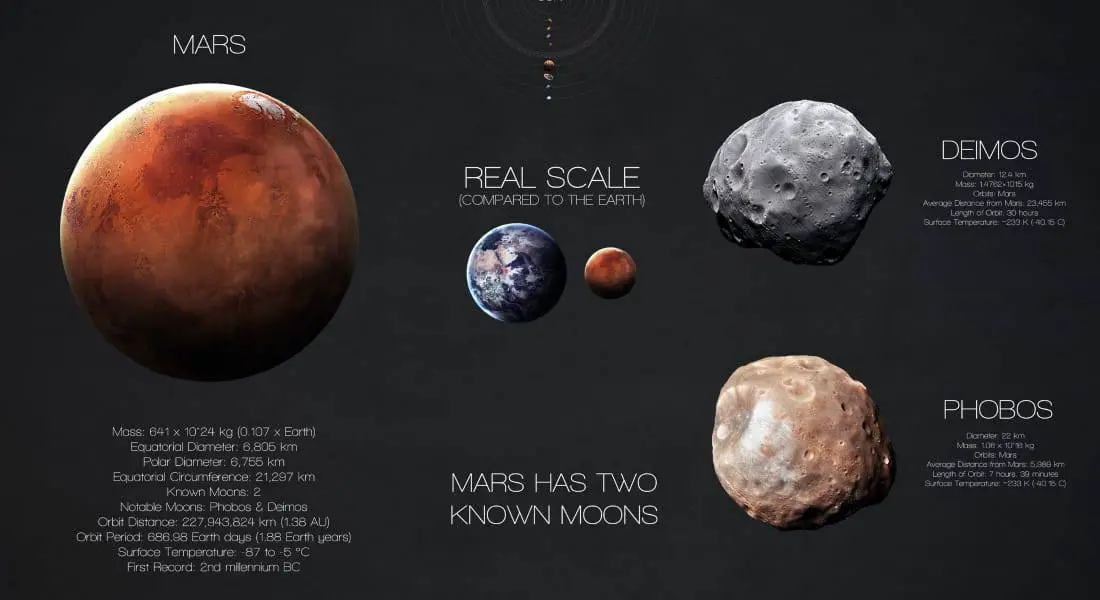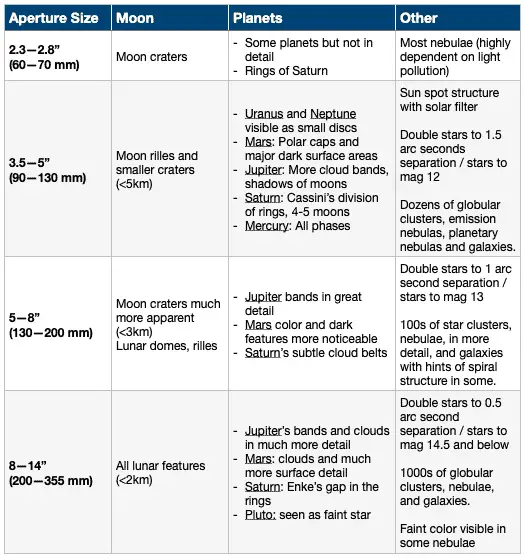You might be wondering what magnification works best for getting a close-up of Mars and what features you’re likely to see? Polar caps, moons? You know how Mars is the red planet but what and how can you see beyond a red disk? Let’s dive in…

A bit about Mars: Mars has an apparent magnitude or brightness observed from Earth of +0.71. It is bright but not as bright as Saturn, Sirius, or Jupiter.
Can You See Mars With A Telescope as a backyard astronomer?
Yes, you can see Mars with a home telescope. Mar’s reddish hue means you can easily discern it from other celestial objects in the night sky. You don’t need a telescope to see Mars but with one properly aligned and with good focus, you’ll get to see more of Mars than just a reddish glowing dot in the sky.
The best time to observe Mars is during the time when it is in opposition, e.g., 8 December 2022 and others listed below. But what can you expect to see of Mars through a telescope at this time?
See also: What Does Venus Look Like Through a Telescope
What you see of Mars through telescope from Earth
Mars is one of the best three planets to observe through a home telescope because of its proximity to Earth.
It’ll appear as a round reddish object. Don’t expect a bright red object. The red shade will be dull. The other distinguishing feature you might see is a polar cap.
At the best viewing times (within a few weeks every 26 months around when Mars is in opposition) you might get to see a polar cap, a white coloration at the ‘top’ or ‘bottom’ of your view. Also, because the distance between Mars and Earth varies, some opposition times will be better than others.
Be patient and train your eye to see this phenomenon more clearly — it may take days. As planetarium director, John Mosley, says in the Starry Night companion: “Mars is a challenging object…Practice is essential”.
Patience and perseverance can pay off, as I explain in my article on maximizing your views of planets. You might be rewarded with not only a polar cap, but also see major features depicted as dark contrasts on Mars’ surface. You’ll learn more about these below.
The standout Mars features
Mars is half the size of Earth with an atmosphere 0.7 percent as dense as Earth’s. As Dickinson explains in NightWatch: “Mars is the only planet whose surface features re clearly visible from Earth”.
The prominent features of Mars:
- Dark marks
- Polar caps
- Moons
Look for a polar cap, depending on the season, or the tilt of the planet, you’ll see this on Mars through a telescope providing the atmospheric conditions are good, Mars is close to Earth, and you have the right power in your telescope to view Mars.
Like all inner planets, Mars is a rocky one (as compared to outer planets, that are gaseous). You might see darker patches. Non-active volcanoes and canyons mark the surface of Mars — but you most likely won’t distinguish these beyond seeing dark patches.
The major dark areas that stand out are the non-active volcano, Syrtis Major (see photo below), and the plain, Acidalia Planitia. Another plain, Chryse Planitia, is where Viking 1, the first US spacecraft for Mars, landed. You may get a quick glance at this.
Why is Mars red?
Mars is red because of iron minerals oxidizing (rusting) and bringing about the red hue of the soil and atmosphere.
Does Mars have clouds?
Yes, Mars has thin water-ice clouds. They’re seen in the below photo composed of images taken of Mars through Hubble telescope in 2016.

Viewing Mars from an Earth telescope has limitations, but the Hubble telescope gives up much more detail, as seen in the composite photo above, constructed from imagery acquired by Hubble’s WFC3 camera.
Can I see the moons of Mars in telescope Views at home?
Probably not.
Your best bet are the NASA composite photos constructed of Mars through Hubble telescope camera captures or the like, that show the Martian moons.
The moons are clearly visible in shots of Mars taken in open space (see photo below).
How many moons does Mars have?
Mars has two known moons, Demos and Phobos, which are odd-shaped, as compared to our Moon, which appears round. Demos and Phobos are ‘lumpy’. But, like our moon, they are heavily-cratered.
When can you see Mars with a telescope?
At different times of the year, you’ll see Mars in the night sky rising above the horizon. It’s a good idea to check online schedules for when best to see Mars for your specific location. Dateandtime.org is one place to source this information.
As well, most popular astronomy apps for your device have such events listed.
A telescope view of Mars is ultimate when the planet comes closest to Earth, e.g. 13 October 2020 at a 0.4181 AU distance. The next time it is this close is in 2035, a 15-year gap.
Best time to view Mars
| Opposition Dates | Mars’ distance from Earth | Location |
| 8 December 2022 | 0.5492 AU | Taurus |
| 16 January 2025 | 0.6435 AU | Gemini |
| 19 February 2027 | 0.6780 AU | Leo |
Views of Mars through a telescope 2020 opposition
Views of Mars through telescope 2020 month of October, when Mars was closest to Earth (0.4182 AU), were captured by astronomy photographers around the world. The 6th of October was when it was at its closest point to Earth.

How to find Mars With a telescope
Use sky maps or star charts to find Mars in the night sky. A star finding app is useful and I mention a worthy selection in my sky map article.
When you have a general idea of the location, maneuver your telescope to that area and use the finderscope of your telescope to find Mars.
If you have a GoTo or an automatic driver for finding night sky objects, simply program the computer to search for Mars and track it as it appears to move across the sky. If you considering astrophotography being able to finely track it is essential.
How powerful of a telescope do you need to see Mars?
Looking for a telescope to view Mars with enough power to see its surface features? Telescopes of apertures of 5 inch upwards to 8 inch in a reflector telescope are ideal to see surface color, polar caps, and noticeable dark features of Mars (as well as the moons and bands of Jupiter, and rings of Saturn).
Mars through 8 inch telescope will give you great views but don’t be too disappointed if you have something smaller. You can still see major dark surface areas and polar caps of Mars with a 3 — 5″ aperture, with practice and training of mind and eye over several sittings.
If you are wanting to see clouds you are going to a need an 8 inch reflector and upwards to 14 inch, which isn’t the most practical.
The above is a guide that includes what you are likely to see of Mars through telescope observations based on aperture size. What you actually see, however, will depend on a few variables, including light pollution, quality of optics, atmospheric conditions, and practise.
You may be wondering about power (magnification).
Magnification of telescope to see mars’ features
Magnification is how much a telescope enlarges its subject. You get this based on the focal length of the telescope and that of the eyepiece you’re using.
Magnification = telescope’s focal length ÷ the eyepiece’s focal length.
Mars is a small object and contrast is not an issue so you can go full throttle with the magnification. This means use the highest useful magnification of your telescope.
As a guide, you can easily work out this maximum useful magnification from the aperture size…
It is expected somewhere within 50× the aperture in inches (or 2× the aperture in mm) of the aperture. Be aware that this is the optimal amount and the amount decreases with declining atmospherice conditions. So include a bit of leeway in this case and try for 25x to 30x the aperture size.
I cover more on this in My Best Telescope For Viewing Planets Buyer’s Guide.
FAQs
In closing
The red planet, Mars, is a close neighbor to Earth. You don’t need a telescope to view Mars. Visible with the naked eye, Mars appears like a star with a reddish tinge in the night sky. Viewing Mars through a telescope, however, reveals its reddish surface marked by dark regions and if you time it right, you may see at least one white polar cap.
Info sources
NASA: About Mars | USGS: Planetary Names | Dateandtime.com: Night Sky Map
Marspedia: https://marspedia.org/Observing_Mars_with_a_Telescope
Nightwatch, a Practical Guide to Viewing the Universe by Terence Dickinson (available at Amazon – affiliate). This book contains sky charts and has a spring binding and so is practical for use on location.
John Mosely in Starry Night Companion. Space Holding Corp. Toronto, Canada.



